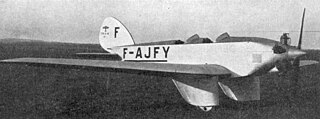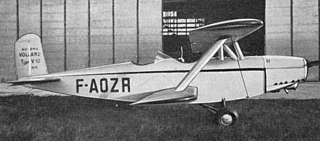Related Research Articles

The Koolhoven F.K.42 was a parasol-wing, two-seat training monoplane manufactured by Koolhoven in the Netherlands. Only one was built.
The Latécoère 14 and Latécoère 16 were similar French passenger and postal aircraft of advanced design built in 1923. They differed chiefly in engine power. Only one of each was constructed. The 14's type number was reused for an unrelated parasol wing prototype that was basis of the more successful Latécoère 17.
The Farman F.280 was a three engine, cantilever wing monoplane designed in France as a mail carrier in the early 1930s. Underpowered and slow, only two were built and briefly used.

The Farman Moustique is a family of French monoplanes built by the Société des Aéroplanes Henry et Maurice Farman at Billancourt.

The Potez 37 was a two-seat, long range reconnaissance aircraft built to compete for a French government contract. It flew in mid-1930 but did not win the competition, so only two were completed.
The Lioré et Olivier LeO 8, Lioré et Olivier LeO 8-Cau 2 or Lioré et Olivier LeO 8 CAN 2 was a French two seat, parasol wing monoplane night fighter and reconnaissance aircraft, built in 1923.
The Bloch MB.90 was the first all-metal French light aircraft. Only two aircraft were completed, making their first flights in 1932, though there were several variants.

The SFCA Lignel 20 was a French, single engine, low wing monoplane, one of a series of this type built by SFCA in the 1930s. It was capable of aerobatics but was primarily a racing aircraft.

The SFCA Lignel 10 was a French single seat aircraft designed to bridge a training gap between basic trainers and front-line fighters. The military requirement was soon dropped and only one was built.

The Albert A-60 was a single engine, two seat, wooden sports monoplane designed and built in France in the early 1930s. Two were built and flown with three different engines.

The Volland V-10 was a French two seat, low-powered biplane notable for its extreme stagger. It first flew in 1936 and appeared at the Paris Aero Salon that year.

The Wibault 260 R.2 was a contender for a French government contract for a long range, two seat reconnaissance aircraft, issued in 1928. There were eight prototypes in the 1931-2 contest and the Wibault was not selected for production.

The Nieuport-Delage NiD 580 R.2 was a contender for a French government contract for a long range, two seat reconnaissance aircraft, issued in 1928. There were eight prototypes in the 1931-2 contest and the NiD 580 was not selected for production.

The Guillemin JG.10 or Blériot-Guillemin JG.10 was a French two seat touring aircraft, designed to be as simple and safe to fly and maintain as a car, with similar facilities, as well as provision for parachutes.
The unsuccessful French Farman F.200 of 1923 shared its type name with the 1929 Farman F.200, the progenitor of a series of parasol wing tourers. It was a two-seat touring aircraft, with a low, thick, cantilever wing. Only one was built and only briefly tested.
The Peyret Avionette was a low power, single seat French monoplane which won several first-place prizes at the Congrès Experimental contest of 1923.
The Marais avionette was a single seat, low-powered cantilever monoplane built in France in 1923 to compete in a newspaper-sponsored tour contest. Engine selection problems prevented it from taking part. It was modified into a glider for a later competition but crashed during qualification. It was one of the first aircraft to have a retractable undercarriage.
The Carmier Simplex 10 hp was a French tailless, low power, single seat aircraft built in 1923 for a contest arranged by a Paris newspaper. Only one is known to have been completed and its career was brief.
The Sergant A was a French 4-cylinder, air-cooled, upright inline piston engine with a maximum output of 7.5 kW (10 hp), designed to meet the needs of the very small and light single seat sports aircraft of the early 1920s. It was used by at least ten different types.

The Dewoitine 14 was a mid-1920s French civil transport, capable of carrying mixture of passengers and freight. The sole example was used in commercial trials.
References
- ↑ "Le Grand-Prix du "Petit Parisien"". Les Ailes (114): 1–2. 12 July 1923.
- 1 2 "Deux importantes inscriptions". Les Ailes (99): 2. 10 May 1923.
- 1 2 3 4 5 Serryer, J (6 September 1923). "Le "Colibri" Louis Breguet". Les Ailes (116): 2.
- ↑ "Le Moteur Sergant 16 HP". Les Ailes (109): 2. 19 August 1923.
- ↑ Frachet, André (19 July 1923). "(Lucien Coupet, sur Farman-Salmson ..." Les Ailes (108): 1–2.
- ↑ Claparède, E (24 January 1924). "Ce que fût le meeting de Nimes". Les Ailes (106): 2.
- ↑ "Le Breguet". L'Aéronautique. 5 (50): 275. July 1923.